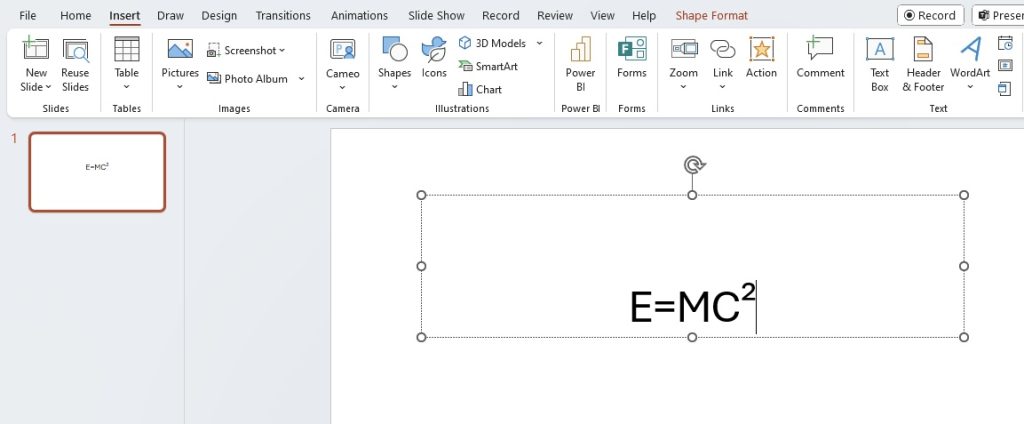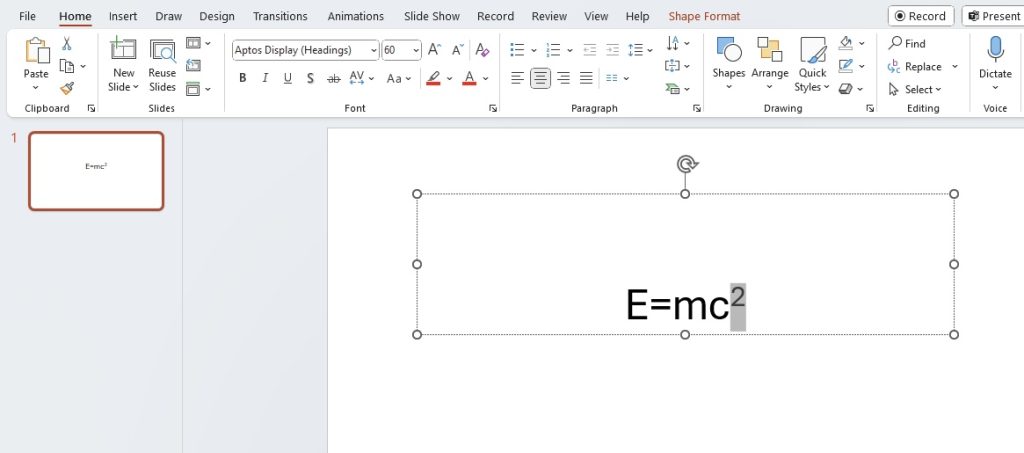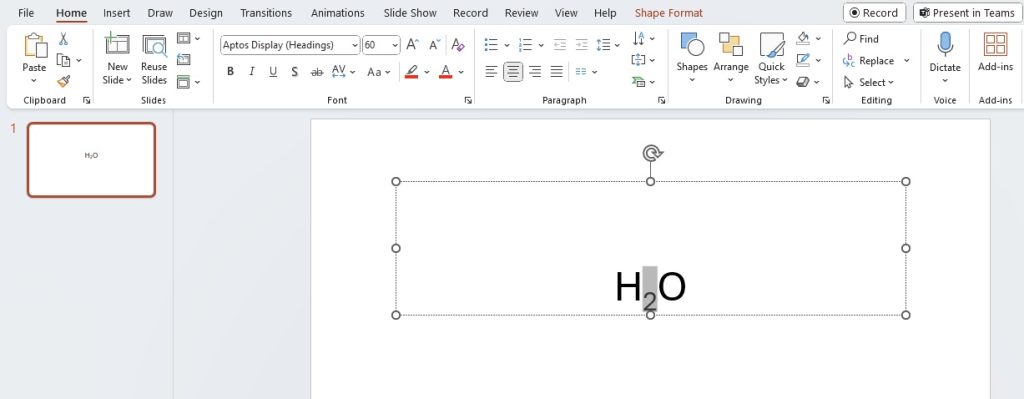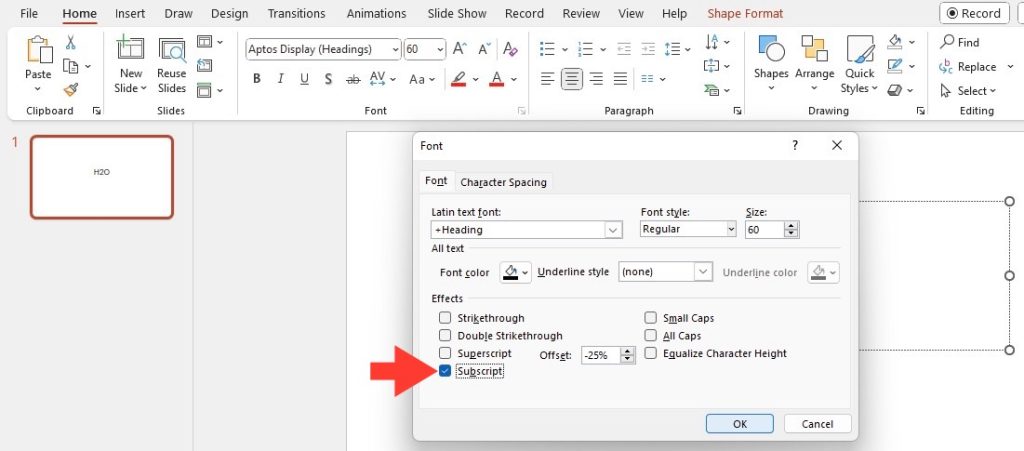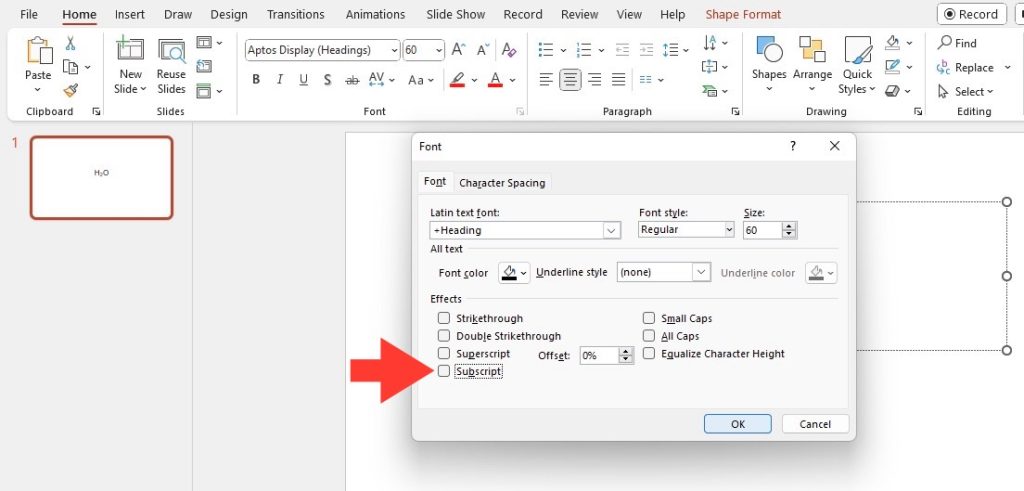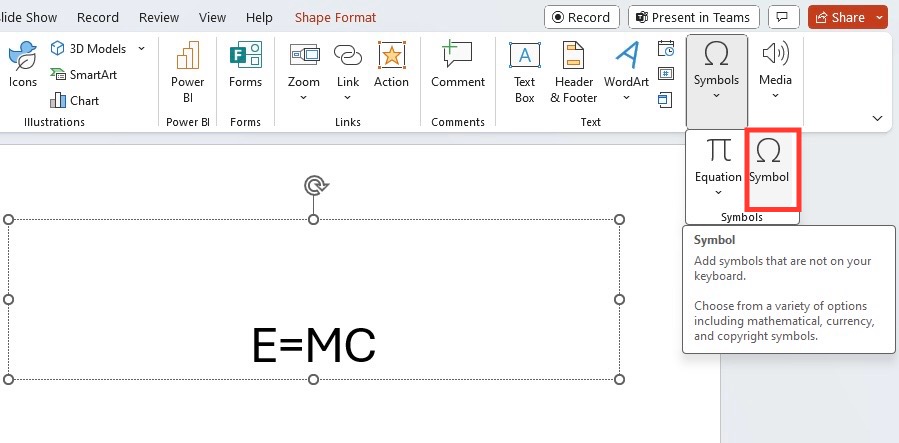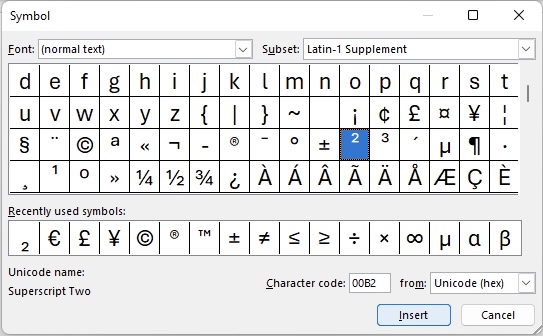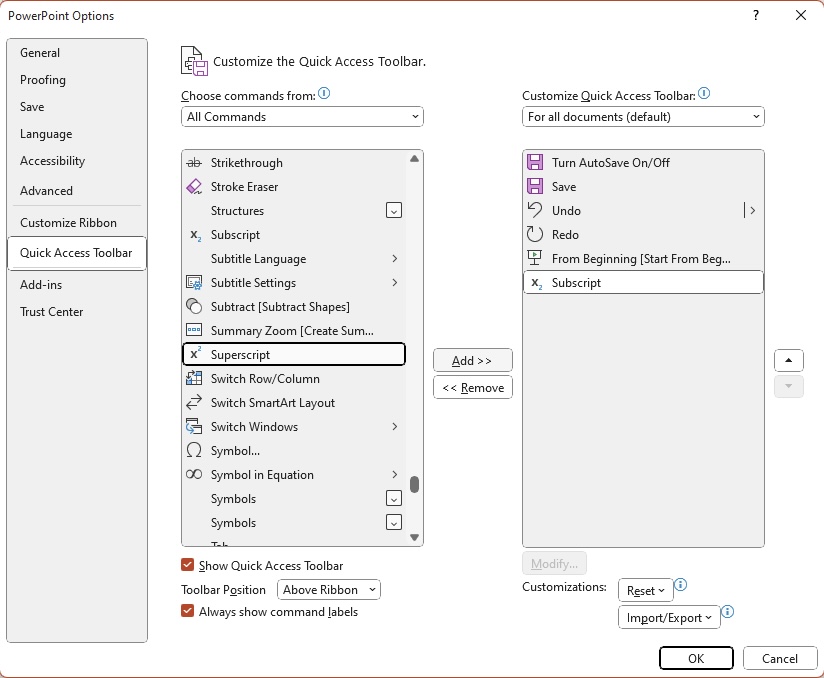Learn about Excel Formulas with our 101 Advanced Excel Formulas & Functions Examples!
Key Takeaways
- To format text as superscript in PowerPoint, you can utilize the “Font” settings option, allowing you to change text properties through a dialog box.
- For quicker access, you can add superscript and subscript options to the Quick Access Toolbar, ensuring these tools are always visible and readily available.
- Keyboard shortcuts offer a fast and convenient method to toggle superscript or subscript formatting while working on your presentation; these shortcuts vary depending on the operating system but are typically a combination of keys like “Ctrl” plus a specific letter or function key.
Use Cases for Superscript:
- Mathematical equations (E.g., E=mc²).
- Scientific notation (2.998 x 10⁸ for the speed of light).
- Ordinal indicators (1st, 2nd, 3rd).
- Trademark notations (Brand™).
Keyboard Shortcuts for Quick Superscript Formatting
Speed is of the essence when you’re in the flow of creating a presentation. Using keyboard shortcuts can save precious time. For superscript in PowerPoint, the quick and effective shortcut is:
- Superscript Shortcut: Ctrl + Shift + Plus
By pressing these keys simultaneously, the selected text jumps above the baseline, transforming into a superscript. To return to normal text, just hit the same combination once more.
Tips for Swift Formatting:
- First, highlight the text you want to change.
- Use the shortcut.
- Continue typing as normal, or repeat for additional superscript entries.
Table of Contents
Diving Low: Mastering Subscript in PowerPoint
Understanding the Role of Subscript in Presentations
While superscript takes your text to a higher level, subscript helps to ground your information by placing certain characters slightly below the regular text line. You may notice them behaving like roots keeping the tree of knowledge firmly planted in your slides.
When You’ll Need Subscript:
- Chemical compounds and formulas like H₂O and CO₂.
- Mathematical expressions to denote bases in logarithms (log₄ x).
- Denoting variables in statistical formulas.
By using subscript in your presentations, you might convey complexity and detail with simplicity and clarity.
Understanding the role of subscript isn’t just about knowing where to use it; it’s about knowing why it’s pivotal for comprehension in your audience. It’s not just a design choice—it’s a tool for better communication.
Convenient Methods to Apply Subscript with Ease
Applying subscript in PowerPoint doesn’t have to be a multi-step process. Whether you’re detailing the finer points of chemical molecules or foundational math principles, here’s how you can bring your text down to size in a snap.
Keyboard Shortcut for Subscript:
- Subscript Shortcut: Ctrl + ‘=’
This method is a quick fix for subscript needs. Just select the text you wish to format and hit the shortcut keys. To revert back to standard text formatting, simply use the same shortcut again.
Alternate Method:
- If shortcuts aren’t your thing, make use of the ‘Subscript’ button located in the ‘Font’ group of the ‘Home’ tab in PowerPoint’s ribbon.
Remember, effective communication often lies in the details, and subscript can be that crucial detail that makes your data stand out.
Accessibility Tip: If you use subscript often, consider modifying your Quick Access Toolbar to include the subscript function for even speedier formatting.
Editing Power: Undoing Superscript & Subscript
Mistakes Happen: How to Undo Formatting Fast
Oops! Applied the wrong text effect? Don’t worry; PowerPoint has you covered. If you’ve got a bit too trigger-happy with your formatting, you can quickly step back and rectify any superscript or subscript mishaps.
Quick Undo for Superscript and Subscript:
- Reset Formatting Shortcut: Ctrl + Spacebar
Just select the text that’s been mistakenly formatted and press these keys together to return it to its default state. If your misstep is fresh, Ctrl + Z will become your best friend, allowing you to immediately undo your last action.
Undoing Formatting in Bulk:
- Highlight the segments of text you want to clear formatting from.
- Use either the reset shortcut or the undo function for each segment.
Remember, when it comes to presentation editing, ‘Ctrl + Z’ and ‘Ctrl + Spacebar’ are the magical combos that keep your slides polished and mistake-free.
Keeping Slides Clean: Removing Unwanted Text Effects
Maintaining clarity and readability is key to a powerful PowerPoint presentation. Unwanted text effects can distract and confuse, but thankfully, they can be tidied up with just a few clicks.
How to Remove Superscript or Subscript:
- Select the text with the unwanted effect.
- Navigate to the ‘Font’ group under the ‘Home’ tab.
- Click on the ‘Superscript’ or ‘Subscript’ button to toggle the effect off.
Clean-Up Advice:
- Keep an eye on the text consistency across your slides.
- Regularly review your slides in ‘Slide Sorter’ view to catch any formatting inconsistencies.
- Use ‘Clear All Formatting’ to reset text to the default font and size, ensuring a clean slate.
Remember, sometimes less is more. If superscript or subscript doesn’t serve a clear purpose, it’s best to keep things simple and stick to the standard text. Your slides will thank you for it!
Customization Tips: Adjusting Position of Superscripts & Subscripts
Fine-Tune Your Text: Manual Adjustments for Precision
For those occasions where you need pinpoint accuracy, PowerPoint allows you to manually adjust the position of your superscripts and subscripts. This is especially handy when you’re dealing with non-standard fonts or particular design requirements that call for a tailor-made touch.
Steps to Manually Adjust Text Position:
- Highlight the superscript or subscript text.
- Click on the ‘Font Dialog Box Launcher’ in the ‘Font’ group under the ‘Home’ tab.
- In the ‘Font’ tab, look for the ‘Effects’ section and find the ‘Offset’ box.
- Enter a positive value to move the text up (for superscripts) or a negative value to move it down (for subscripts).
- Click ‘OK’ to apply the changes.
Handy Tips for Manual Adjustments:
- Small incremental changes can make a significant difference. Start with small values.
- Preview your slide after each adjustment to check for visual alignment.
- Consider consistency. Ensure all similar text elements across your presentation match in positioning.
Remember, it’s not just about making it look good; it’s about creating functional harmony in your design. Manual adjustments can help you achieve that extra layer of customization that sets your slides apart.
Enhancing Readability and Visual Appeal
While superscript and subscript are crucial for accurate information display, they shouldn’t compromise the legibility of your slides. Striking a balance between precision and visual appeal is key.
Tips to Enhance Readability:
- Contrast: Ensure your text stands out against the background. This might mean lightening a dark background or choosing a font color that pops.
- Font size: Even though superscript and subscript text is smaller, make sure it is still readable. Avoid going below 8pt size.
- Simplicity: Use these text effects only when necessary to avoid cluttering your slide.
- Alignment: Keep your text aligned both horizontally and vertically for a clean, professional look.
- Spacing: Give your superscripted or subscripted text breathing room so it doesn’t run into the following text.
Enhancing the visual appeal of your slides doesn’t only make your presentation look better; it makes it more effective. After all, a presentation that’s easy on the eyes is one that keeps your audience engaged.
Advanced PowerPoint Tricks: Special Characters and Symbols
Adding Flair to Slides with Superscript and Subscript Symbols
Take your presentations up a notch by incorporating superscript and subscript symbols! These aren’t just for technical jargon—they can add a creative touch and emphasize important details.
How to Insert Superscript and Subscript Symbols:
STEP 1: Navigate to the ‘Insert’ tab.
STEP 2: Click ‘Symbol’ > ‘More Symbols’.
STEP 3: Choose ‘(normal text)’ from the ‘Font’ dropdown.
STEP 4: Select ‘Superscripts and Subscripts’ from the ‘Subset’ dropdown.
STEP 5: Click to insert your desired symbol, and then close the dialog box.
The addition of special symbols can:
- Clarify meanings (e.g., placing the correct phase symbol in chemical equations).
- Highlight important legal or copyright markings (e.g., ®, ©).
- Add a creative spin or branding element to your presentation (e.g., artistic textual effects).
In essence, these symbols act as the jewelry of your textual content—use them sparingly and they’ll make your slides sparkle!
Beyond Basic Text: Inserting Special Characters
Sometimes your message needs more than just words. Special characters can be the secret sauce that gives your slides that extra zest. Whether it’s mathematical symbols, foreign language letters, or unique icons, PowerPoint lets you go beyond the basic alphabet.
Steps for Inserting Special Characters:
STEP 1: Click on the “Insert” tab.
STEP 2: Go to “Symbol” and then “More Symbols”.
STEP 3: Dive into various fonts and subsets to find a whole world of special characters and symbols.
STEP 4: Click the character you want to add, then click “Insert”.
Why Special Characters Matter:
- Precision: For scientific or mathematical data, accuracy is non-negotiable. Special characters ensure you’re technically correct.
- Cultural Awareness: Including accents and characters from different languages shows respect and attention to detail.
- Engagement: Unusual and fun characters can capture attention and break up text-heavy slides.
By expanding your character repertoire, you’re not just adding to your slides—you’re adding depth to your communication and connection with your audience.
Streamlining the Process: Quick Access Toolbar
Tailoring Your Toolbar for Efficiency
Becoming a PowerPoint whiz often involves optimizing your workspace for efficiency. Tailoring your Quick Access Toolbar by adding frequently used commands like superscript and subscript can streamline your workflow.
How to Customize Your Quick Access Toolbar:
STEP 1: Right-click on the main PowerPoint ribbon.
STEP 2: Select ‘Customize Quick Access Toolbar’.
STEP 3: In the ‘Choose commands from’ dropdown, select ‘More Commands’.
STEP 4: Scroll through the list, find ‘Superscript’ and ‘Subscript’, and add them.
STEP 5: Click ‘OK’ to save your customized toolbar setup.
Efficiency Gains:
- Time-Saving: No more digging through menus for every text adjustment.
- Convenience: Your most-used functions are always at the top, just one click away.
- Focus: Spend less time formatting and more on crafting your message.
With your toolbar tailored to your needs, you’ll notice the pace of your slide creation pick up speed, letting you focus on the creative aspects of your presentation instead of the mundane.
FAQs: Superscript & Subscript Simplified
What is the easiest way to apply superscript in PowerPoint?
The easiest way to apply superscript in PowerPoint is by using the keyboard shortcut. For Windows, press Ctrl + Shift + + and for Mac, use Command + Shift + +. This instantly formats the selected text as superscript.
Can I add subscript formatting to multiple text elements at once?
Yes, you can add subscript formatting to multiple text elements at once in PowerPoint. Simply highlight all the text elements you want to change and then apply the subscript format either using the Font dialog box or the keyboard shortcut Ctrl + =.
How do I access special superscript and subscript characters?
To access special superscript and subscript characters in PowerPoint, go to the ‘Insert’ tab, click ‘Symbol’, then ‘More Symbols’. Choose ‘Superscripts and Subscripts’ from the ‘Subset’ dropdown. From here, select and insert the special characters you need.
Is there a way to adjust the default position of superscript and subscript in PowerPoint?
PowerPoint doesn’t offer a feature to set a default position for superscript or subscript. However, you can manually adjust each instance’s position by selecting the text and editing the ‘Offset’ value in the ‘Font’ dialog box under ‘Effects. Repeat as needed for consistency.
John Michaloudis is a former accountant and finance analyst at General Electric, a Microsoft MVP since 2020, an Amazon #1 bestselling author of 4 Microsoft Excel books and teacher of Microsoft Excel & Office over at his flagship MyExcelOnline Academy Online Course.

